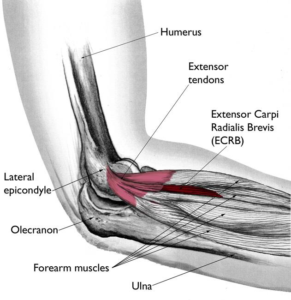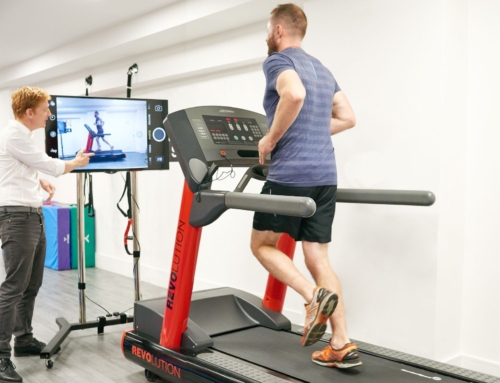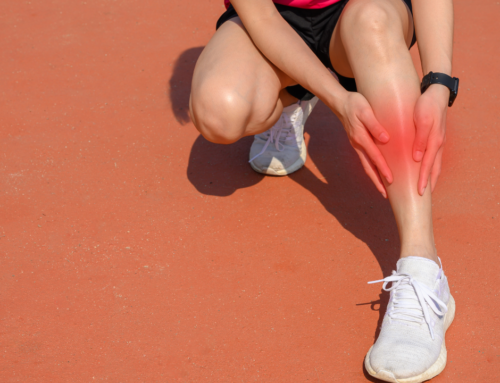Tennis elbow, also known as common extensor tendinopathy and lateral epicondylalgia, is a very common condition affecting the muscles and tendons that extend your fingers and wrist, causing pain on the outside of the elbow. The pain is particularly aggravated when you grip objects and play racquet sports. Pain can also spread into your forearm and wrist.
The pain is usually a dull ache or burning pain that is aggravated by activities involving gripping. Despite the name, tennis elbow only affects a small percentage of tennis players. It is typically caused by any activity that puts repeated stress on the muscles and tendons that attach on the outside of the elbow joint, including painting, gardening, DIY, or even frequent computer use.
We are dedicated to helping you achieve your personal goals, whether it is picking up a cup of tea or playing tennis at Wimbledon with no elbow pain!
We will structure your treatment programme specifically to your goals and will support you through the process from diagnosis to return to your activity or sport.
Anatomy for Tennis Elbow
The elbow joint is the point of articulation between the upper arm and the forearm. It is made up of three bones, the humerus (upper arm bone) and the radius and ulna (the bones of the forearm). The elbow joint is held together by ligaments, tendons and muscles, which all work in partnership to provide mobility, stability, and strength to the elbow.

Your forearm muscles extend your wrist and fingers. Your forearm extensor tendons attach these muscles to the bones in your elbow. The extensor tendons attach onto the bony bump on the outside (lateral side) of the elbow (the lower part of your humerus) called the lateral epicondyle; hence the condition also being known as lateral epicondylalgia. This is where the site of pain is. The tendon usually involved in tennis elbow is called the extensor carpi radialis brevis (ECRB).
What causes Tennis Elbow?
It is an overuse injury; as the muscles of your wrist and hand repeatedly contract, it can cause a strain on the tendon or tendons that attach onto the outer elbow (lateral epicondyle). This excess strain results in minor tears in the tendon (microtrauma), which then becomes painful and inflamed. Tendon irritation is often known as tendinitis or tendinopathy.
If the pain persists over a longer period of time (more than a few months), the problem can become chronic which can make it more difficult to treat.
It almost always affects your dominant hand.
Common causes include:
- Unaccustomed activity and hand use, e.g. painting a fence, DIY, or excessive typing and mouse work.
- Activities or sports that involve excessive gripping.
- Muscle imbalances – weak forearm muscles or tight muscles.
- Poor stability and strength around the shoulder girdle.
- A poor technique i.e., a poor tennis or squash shot (usually back hand).
- Incorrect equipment i.e computer equipment, tennis/squash racquet or grip size.
Risk factors for Tennis Elbow
There are several risk factors which may make you more susceptible to experiencing tennis elbow:
- Age – It is most common in adults between 30 and 50 years old, though it does affect people of all ages.
- Occupation – It often affects typists or people who do a lot of computer work, painters, carpenters, plasterers, plumbers, chefs, and other professions that require some degree of repeated motion in the wrist and forearm.
- Sport/Activity – It is more prevalent in those that play racket sports such as tennis and squash, golf, and also in individuals that lift weights in the gym.
What are the symptoms of Tennis Elbow?
Typically someone suffering from tennis elbow will experience pain when performing gripping tasks or resisted wrist/finger extension such as lifting a kettle, gripping weight and playing sports. There will be tenderness directly over the outside of the elbow over the bony epicondyle, and there may also be painful points in the muscles along the forearm. Pain can be present when the forearm muscles are stretched and some people may also have neck stiffness and tenderness. Most elbow movements will be pain-free (unless gripping hard at the same time), despite that being the area of pain.
The symptoms of tennis elbow usually begin to appear gradually, as the condition is a progressive one, rather than related to an acute injury. As the condition progresses, the associated pain gradually increases over the course of a few weeks or months.
Common signs and symptoms of tennis elbow:
- Ache or burning pain on the outer elbow, gradually increasing over time.
- Reduced grip strength.
- Usually affects the dominant arm.
- Pain worsens with sports or activities that require gripping.
- Pain is often also felt while performing basic actions, such as writing or when gripping small objects, lifting a kettle, turning a door handle or opening a jar.
- Tenderness to touch on the bone and muscles on the outside of the elbow.
- Swelling on the outside of the elbow.
- Excruciating pain if you knock the outside of your elbow on a wall or door.
If you are experiencing symptoms of tennis elbow and would like to book in to see one of our expert physiotherapists, please call 020 7482 3875 or email info@complete-physio.co.uk. If you would like to speak to a specialist before booking, please email us with your details and we will call you back.
How do we diagnose tennis elbow?
Obtaining an accurate diagnosis of tennis elbow is essential. It allows the clinician to select the most effective treatment plan for you. A diagnosis will be made by your physiotherapist who will carry out a comprehensive subjective and clinical assessment. It is not essential at this stage to have a scan.
They will ask questions about your past health, symptoms, and exercise regime, which will give your clinician a good indication of your diagnosis.
After your consultation, the specialist physio will complete a series of tests to help confirm a diagnosis. This may include:
- Assessing the range of movement and strength of your wrist, elbow, and shoulder.
- Assessing your grip strength.
- Measuring muscle length and flexibility of your forearm and upper limb.
- Checking other regions of the body as needed, such as your neck, back and shoulder. This will help to determine if other areas also require treatment to improve your condition.
- Gently, but skilfully, feeling around your elbow and forearm, to find exactly where it is most painful.
- Functional tests – if your pain is present during a specific activity or task, you may be asked to perform these, so the physiotherapist can assess exactly what is aggravating your pain.
- There is a specific test called the “Mills test” which is an accurate clinical test for diagnosing tennis elbow.
The clinical assessment is normally sufficient to diagnose tennis elbow. However, it is limited in providing any further information about the exact structure of the tendon and surrounding tissues, and the severity of the condition. This is where an ultrasound scan can be useful.
Diagnostic ultrasound scan for tennis elbow
A real-time diagnostic ultrasound scan will help to confirm the diagnosis of tennis elbow, ascertain the severity of the problem and to check if you have a tear in your tendon. It provides more detail than an MRI.
An ultrasound scan is able to clearly visualise the tendon structure and inflammation associated with tendinopathy. It is regarded as the gold standard imaging technique for assessing tendon structure and pathology, better than MRI.

An ultrasound scan showing tendinopathy indicating tennis elbow.
An ultrasound scan is better than an MRI scan for visualising the tendon.
The scan allows for accurate assessment of the severity of the problem and can aid in treatment selection. Once a full diagnosis has been made, your clinician will be able to discuss the most effective treatment options with you.
At Complete our clinical specialists will carry out an ultrasound scan as part of their clinical assessment. You do not need a GP referral, and we do not charge extra for an ultrasound scan. Please ensure you inform our administration team at the time of booking if you would like to book an appointment including an ultrasound scan,
To book an appointment to see one of our clinical specialists, please call 020 7482 3875 or email info@complete-physio.co.uk.
X-rays for Tennis Elbow
An X-ray does not show problems with tendons or other soft tissue. However, it may be recommended to rule out any bony abnormalities or a joint condition, such as osteoarthritis.
MRI for Tennis Elbow
An MRI scan is not usually required for diagnosing tennis elbow. However, if we are unsure of the diagnosis or we feel the joint is involved, our physiotherapist may refer you for an MRI scan. An MRI is an accurate way to visualise the deeper structures in the joint, such as the articular cartilage of the joint surfaces, and it will pick up tears in the muscles or tendons. It will also show areas of swelling.

An MRI scan showing fluid in the tendon indicating tennis elbow
Treatment for tennis elbow?
Physiotherapy and rehabilitation for tennis elbow
Complete Physio are trusted by world renowned orthopaedic surgeons and sports medicine consultants to treat their patients suffering with tendon pain, particularly tendon pain which is not improving spontaneously. At the clinic we have treated a variety of patients with elbow pain, from Wimbledon champions, PGA golf professionals to recreational sports and women, and more sedentary individuals who get pain picking up objects.
Your physiotherapist at Complete will provide you with a personally tailored regime for your tennis elbow, based on your clinical assessment.
Generic tennis elbow exercises, particularly those found on the internet do not help everyone! Your programme must be tailored to your own personal goals. For example, the rehabilitation programme for a professional tennis player will be different to a plasterer or brick layer, or someone who wants to simply pick up the kettle or shopping bags with no pain.
This will often include:
- Patient education – it is important to understand your condition and to be active in your recovery. You will be given a clear explanation of the diagnosis, and we will discuss what is required to address your symptoms and reach your goals.
- Relative rest – advice on rest and activity modification allowing your elbow pain to settle and the extensor tendon to heal. In severe cases, it might be that a wrist splint is required to allow the forearm tendons to completely rest for a short period of time.
- Pain management – ice applied to the affected area can be very effective in helping control pain and inflammation. Over-the-counter medication such as painkillers and anti-inflammatories can also ease pain and inflammation.
- Tennis elbow brace and sports taping- when you are returning to activities, a special brace can be worn or specific sports taping techniques used to help offload and reduce the stress on the tendon which will help to reduce the risk of reaggravating your symptoms.

- Specific loading/strengthening exercises – clinical research has shown that heavy slow resistance (HSR) strengthening exercises can have a positive effect on tendinopathy. This is a key component of your treatment programme and requires commitment and consistency. We are specialists at exercise prescription and progression and will develop a bespoke programme for you.
- Range-of-movement exercise – your physiotherapist may teach you active, self-stretching methods. They may also do some hands-on, passive stretching with you. Together, these can really help decrease muscle tightness and tension and restore normal motion of your joints and muscles.

- Manual therapy – your physiotherapist may use manual therapy such as joint mobilisations and soft tissue release techniques to the surrounding muscles. This will help improve movement and reduce muscle stiffness or soreness
- Acupuncture – acupuncture or dry needling treatment has been shown to help provide significant pain relief for tennis elbow. Acupuncture treatment can help to reduce inflammation and improve blood flow to injured areas to aid and speed healing of tendinopathy.
- Muscle strength – muscle weaknesses or imbalances throughout the upper limb can cause or contribute to problems with tennis elbow. Your physiotherapist will design a safe resistance program to ensure all your muscle groups are strong and working in synergy to aid your recovery and prevent recurrence of injury.
- Functional and sports-specific training – once your pain, strength, and range of movement improve, you can begin more demanding, sports-specific rehab.
What if physiotherapy treatment has not worked for your tennis elbow pain?
If physiotherapy options have been unsuccessful, there are a few other treatment modalities available to you. It is important to remember that physiotherapy should always be the key component of any tennis elbow treatment pathway, but we always appreciate that physiotherapy alone does not get every patient better.
The good news is at Complete we provide other treatment options that work in conjunction with physiotherapy to improve your pain and help the tendon to heal.
Shockwave therapy and injection therapy can complement your rehabilitation programme and can significantly reduce your pain and speed up your recovery.
Shockwave therapy for tennis elbow?
Shockwave therapy is an effective, evidence-based treatment option for tennis elbow pain. It produces a series of powerful sound waves which provide a small dose of controlled microtrauma to the forearm extensor tendons. Research has shown that shockwave stimulates the tendons natural healing process, initiating a new healing process. Additionally, local nerve endings surrounding the painful tendon become desensitised by these pulses, resulting in pain and symptom reduction.
Complete Physio’s tendon specialists have shockwave therapy available at three of our clinics. Shockwave is available at our Bury Street (next to the Gherkin), Chelsea, and our Angel clinics.
To book an appointment to see one of our tendon specialists, please call 020 7482 3875 or email info@complete-physio.co.uk. If you would like to speak to a specialist before booking, then please send us an email with your details and we will call you back.
Ultrasound guided injections for tennis elbow?
If your pain persists and you have not improved with physiotherapy or shockwave, then ultrasound guided injection therapy may be appropriate. Injection therapy is used in musculoskeletal medicine to reduce pain and inflammation, allowing you to effectively rehabilitate your condition.
Steroid injection for tennis elbow
Steroid injections may be recommended if pain is persistent and nothing else is working. It is important to remember that the pain relief that steroid injections provide may be short lived and they must be followed up with physiotherapy.
The injections involve a mixture of local anaesthetic and corticosteroid (a potent anti-inflammatory) is injected under the guidance of a real-time ultrasound scan. This is to ensure the affected area is accurately targeted. Research has shown that guided injections are more accurate and are more effective at reducing pain than non-guided injections.
Ultrasound guided platelet-rich-plasma (PRP) injection for tennis elbow
PRP has been clinically proven to enrich the healing process and speed recovery of tendons. It is a natural, safe treatment using components of your own blood to heal the tendon. There are very few side effects and the procedure is well tolerated.
PRP requires a small amount of blood to be extracted from a vein in your arm. This is then spun at high speeds in a centrifuge machine to separate the PRP from the other blood molecules. The PRP is then injected, under ultrasound guidance, in and around the forearm extensor tendons to target the most affected regions. PRP has powerful healing properties allowing the body to regenerate the tendon quickly and effectively.
If a tear in the muscle or tendon is identified on ultrasound, it will be directly injected into the tear to facilitate the healing process. Research results suggest that a series of three injections is required to achieve maximum benefit.
Hyaluronic acid injection
Hyaluronic acid is a naturally occurring substance within the body. There is a growing body of evidence suggesting its efficacy in treating chronic musculoskeletal pathology. It may be used, with a local anaesthetic, as a safe alternative to steroid.
Complete Physio have developed a unique service directly tailored around the wants and needs of our patients. A one-stop shop, fast, efficient and safe service for patients to obtain pain relieving injections for a broad range of musculoskeletal conditions.
Complete Physio has a specialised team of clinicians who have undertaken extensive training to provide this service. They have also completed extensive, regulated training to prescribe medications independently which means we do not require a referral from your GP.
You will need to be booked in with one of our clinical specialists if you think that you might require either an ultrasound scan or an injection. Please make this clear at the time of booking.
Surgery for tennis elbow?
In very rare cases surgery may be a final option. If surgery is needed, a surgical release is performed as a day-case operation. The location of the tendon damage is identified through a small incision, and this portion of the tendon is removed. The underlying bone is exposed, and blood flow to this region is stimulated. The remaining tendon is repaired by using sutures anchored into the bone. Surgery to release the damaged tendon is usually successful, but rarely needed; about 95 percent of patients with tennis elbow can be successfully treated without surgery.
At Complete Physio we have an excellent working relationship with some of the best and most experienced surgeons in the country. If an onward referral is required we will ensure that you are provided with exceptional care, and will continue to support your post-op recovery every step of the way.
If you would like to book an appointment at Complete Physio or speak to one of our expert physiotherapists, please call 020 7482 3875 or email info@complete-physio.co.uk.
Don’t let pain hold you back, book now!





